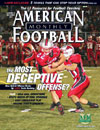AMERICAN FOOTBALL MONTHLY THE #1 RESOURCE FOR FOOTBALL COACHES
Article CategoriesAFM Magazine
|
Multiple Coverages Out of Zone Blitz Schemesby: Mike Kuchar© More from this issue Several months ago American Football Monthly broke down the concepts and philosophies of utilizing a cover three zone blitz. The benefits of the zone blitz are simple: it puts additional pressure on the QB by rushing five defenders while playing softer zone coverage behind it. Not only does it provide a suitable alternative to a strict man blitz concept but its possibilities are endless. You can send any eleven on the field as long as you have three deep defenders and three underneath defenders. But while the prototypical three deep zone blitz concept is very popular among the professional and collegiate levels, its simplicity is starting to take its toll. Offenses are starting to recognize it quicker, and QBs are beginning to get rid of the ball in a hurry and into the hands of their best playmakers. More often than not this r....The full article can only be seen by subscribers. Subscribe today!
|
|
|||||||
| HOME |
MAGAZINE |
SUBSCRIBE | ONLINE COLUMNISTS | COACHING VIDEOS |
Copyright 2025, AmericanFootballMonthly.com
All Rights Reserved





